Recent innovations in floating wind turbines have dramatically advanced offshore energy production, focusing on stability and efficiency. We're seeing designs using semi-submersible and tension leg platforms capable of operating in water depths up to 300 meters, with turbine capacities reaching 22 MW. The introduction of lightweight carbon fiber composites has enabled larger rotor sizes, optimizing energy capture even in low wind conditions. Enhanced mooring systems, including catenary and taut moorings, improve site viability, while smart monitoring and predictive maintenance technologies boost operational efficiency. As we explore these developments, substantial growth opportunities for the industry are emerging.
Key Takeaways
- Recent advancements in floating wind turbines include semi-submersible and tension leg platforms for deeper installations, enhancing offshore energy production.
- Turbines now feature capacities up to 22 MW with larger rotor sizes for improved energy yields, especially in lower wind speeds.
- Innovative materials like carbon fiber composites and biodegradable options are reducing weight and enhancing sustainability throughout the turbine lifecycle.
- Advanced mooring systems and dynamic positioning technology are improving turbine stability and reducing installation costs in deeper waters.
- Smart monitoring and predictive maintenance technologies are optimizing operational efficiency, lowering downtime, and enhancing safety during offshore maintenance.
Recent Technological Breakthroughs
Recent technological breakthroughs in floating wind turbine innovation have considerably transformed the landscape of offshore energy production. These advancements, particularly in semi-submersible and tension leg platforms, enhance stability and allow for deeper installations, greatly expanding the potential for offshore wind farms. With the ability to operate in water depths ranging from 60 to 300 meters, floating wind turbines can now harness energy in previously inaccessible areas. The integration of advanced materials, such as carbon fiber composites, enables lighter, stronger turbine components, facilitating larger rotor sizes for improved energy capture. Additionally, significant installation cost reductions are achieved by fabricating and assembling these turbines in ports, which allows for the use of cost-effective tugboats and cable-laying vessels, rather than expensive installation vessels needed for fixed foundations.
Larger and More Efficient Designs
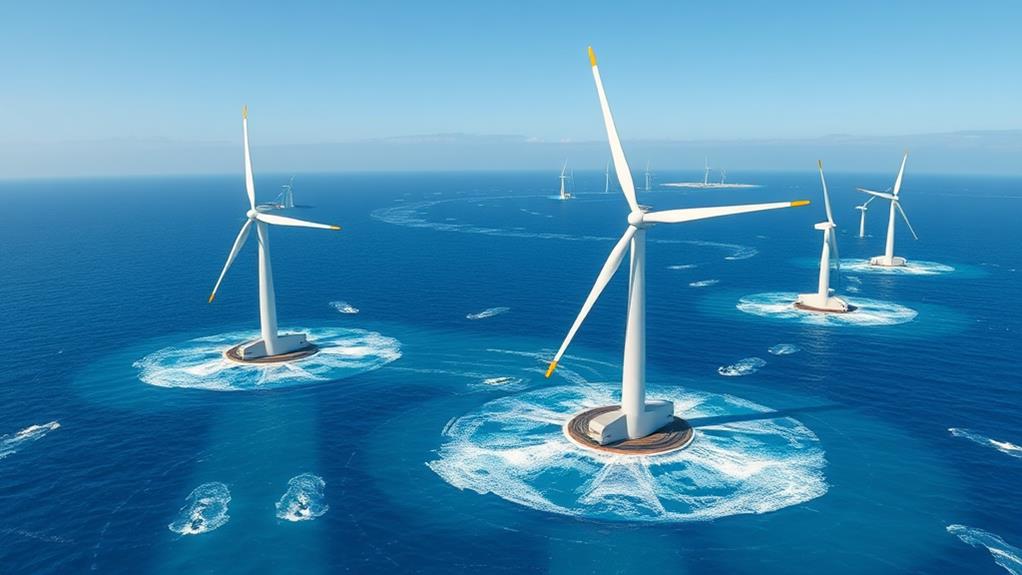
The evolution of floating wind turbine designs is revolutionizing the offshore energy sector, as companies push the boundaries with larger and more efficient models. These advancements are key to maximizing our energy production potential, and here's what we can expect:
- Turbines with larger capacities, reaching up to 22MW
- Increased rotor sizes for better energy yields, even at lower wind speeds
- Use of carbon fiber composites for lighter, stronger components
- Modular turbine designs to streamline transport and assembly
- Floating wind farms designed for depths between 60 to 300 meters, with future capabilities extending to shallower and deeper waters
With these innovations, we're paving the way for more efficient floating wind turbines that not only harness more energy but also enhance the sustainability of our energy systems.
Advancements in Materials
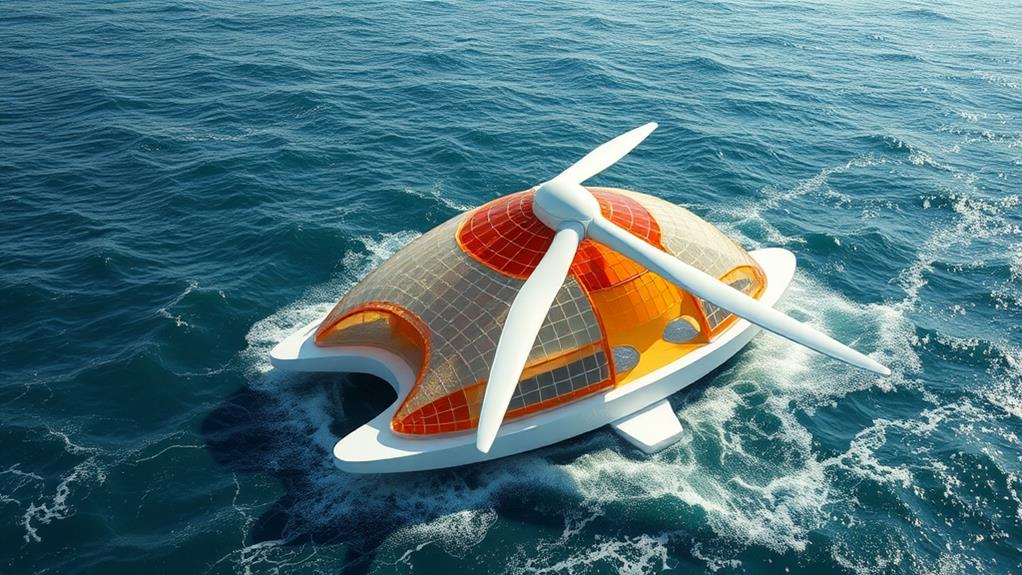
In our pursuit of more efficient floating wind turbines, advancements in materials play a crucial role. The integration of advanced materials, such as carbon fiber composites, greatly enhances strength while reducing weight, enabling larger turbine designs. These innovations guarantee durability and longevity even in harsh marine environments. Furthermore, the shift towards eco-friendly materials minimizes environmental impact across the lifecycle of turbine components. Additive manufacturing techniques facilitate the creation of complex, lightweight parts, which reduces material waste and lowers construction costs. Additionally, enhanced coatings improve corrosion resistance and combat biofouling, essential for maintaining peak performance offshore.
| Material Type | Benefits | Applications |
|---|---|---|
| Carbon Fiber Composites | Strength, lightweight | Turbine blades |
| Eco-Friendly Materials | Reduced environmental impact | Component production |
| Additive Manufacturing | Complex shapes, reduced waste | Structural components |
| Enhanced Coatings | Corrosion resistance | Offshore installations |
| Biodegradable Materials | Lifecycle sustainability | Decommissioning processes |
Enhanced Energy Capture Techniques
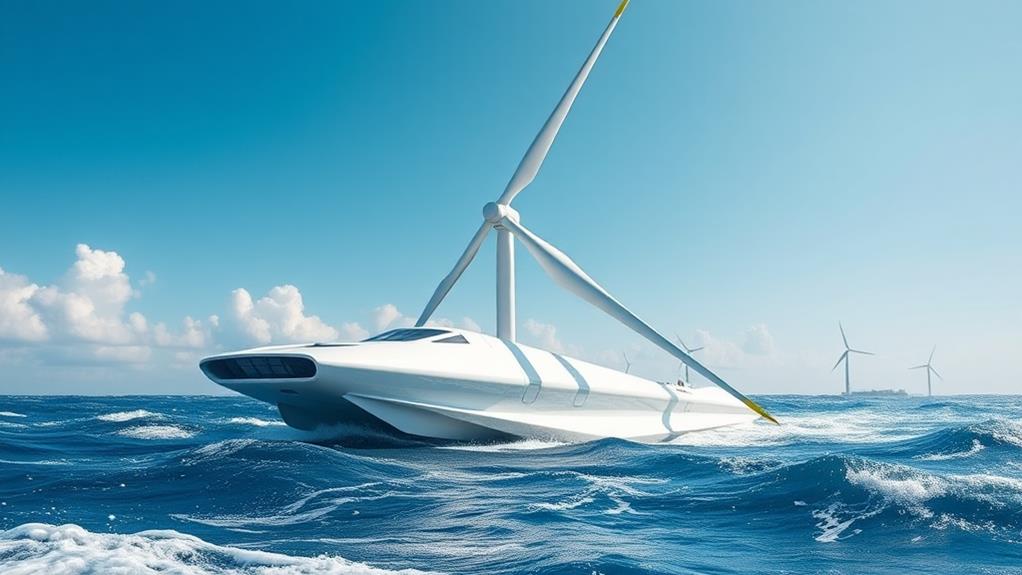
Enhanced energy capture techniques are revolutionizing the efficiency of floating wind turbines, allowing us to harness more power from the wind. By implementing these innovative methods, we can considerably enhance power generation and energy yield. Key advancements include:
- Larger rotor designs for ideal performance at lower wind speeds
- Aerodynamic blade design that minimizes turbulence
- Adaptive pitch control mechanisms for varying wind conditions
- Smart monitoring systems with real-time sensors for operational adjustments
- Advanced materials, such as carbon fiber composites, facilitating larger and lighter components
These enhancements enable floating wind turbines to operate effectively in deeper waters, where wind speeds are typically higher and more consistent. As we explore these techniques, we move closer to maximizing our renewable energy potential, fostering a more sustainable future.
Innovations in Mooring Systems
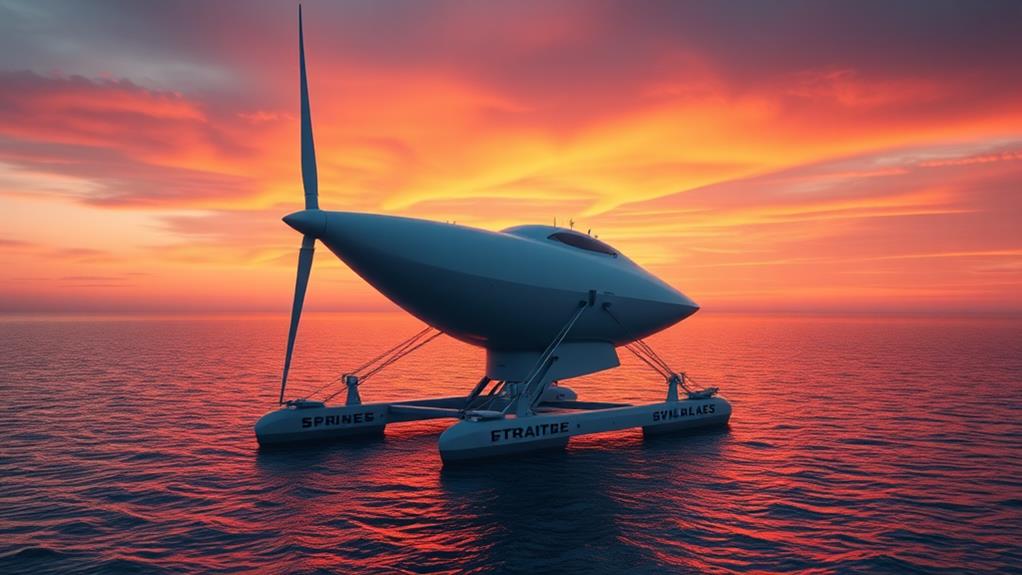
As we explore innovations in mooring systems, it is crucial to take into account advanced anchoring techniques and dynamic positioning systems that enhance the stability and effectiveness of floating wind turbines. By employing methods such as suction buckets and gravity anchors, we can optimize anchoring based on specific seabed conditions, while dynamic positioning systems offer real-time adjustments to maintain the turbine's alignment against environmental forces. These advancements not only improve operational efficiency but also guarantee the long-term viability of floating wind energy projects.
Advanced Anchoring Techniques
Innovative mooring systems are essential for the stability and efficiency of floating wind turbines. We're witnessing remarkable advancements in anchoring techniques that enhance the performance of our floating platforms. Consider the following innovations:
- Catenary moorings utilizing their own weight for stability
- Taut moorings that minimize seabed footprint and movement
- Tensioned Legs Platforms (TLPs) ideal for deep-water installations
- Diverse anchor types, including dragging anchors and suction buckets
- Research aimed at extending operational depths beyond 800 meters
These advanced anchoring techniques guarantee secure attachment to the ocean floor, allowing for larger turbines to be deployed effectively. As we continue to develop efficient mooring systems, the potential of floating wind energy becomes increasingly attainable, paving the way for a sustainable future.
Dynamic Positioning Systems
There's no doubt that dynamic positioning systems represent a significant leap forward in the mooring of floating wind turbines. These systems utilize advanced technology to maintain precise real-time positioning, compensating for environmental variables like wind, waves, and currents. By integrating GPS and sensor data, dynamic positioning systems optimize turbine orientation, maximizing offshore wind energy capture regardless of changing conditions. In addition, innovations like taut mooring configurations work synergistically with these systems to minimize movement, thereby reducing seabed impact. Importantly, employing dynamic positioning can lower installation costs, allowing for smaller, more economical vessels during deployment. As ongoing research enhances reliability and minimizes operational downtime, the economic viability of floating wind farms continues to improve, paving the way for a more sustainable energy future.
Impact on Maintenance Strategies
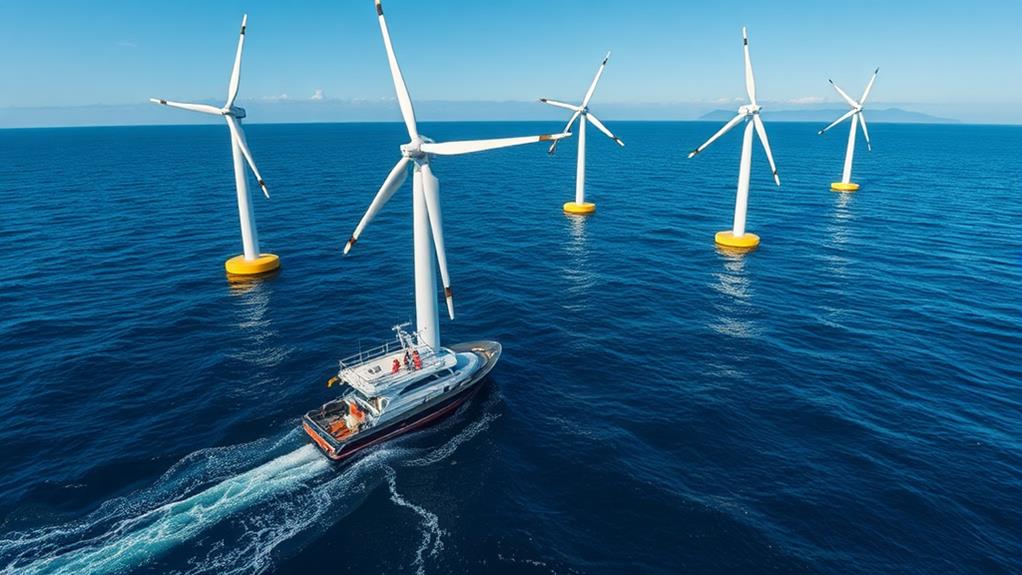
As we examine the impact of floating wind turbine innovations on maintenance strategies, we must consider how advanced maintenance technologies and predictive maintenance approaches are revolutionizing our operations. With real-time monitoring systems that leverage predictive analytics, we can anticipate potential failures, thereby reducing downtime and minimizing costly repairs. Additionally, the logistics and accessibility challenges posed by offshore environments are being addressed through specialized vessels and robotic systems, which enhance our ability to conduct safe and efficient maintenance in these demanding conditions.
Advanced Maintenance Technologies
Embracing advanced maintenance technologies is transforming how we approach the upkeep of floating wind turbines. By integrating innovative tools, we're not just improving efficiency, but also enhancing safety in our operations. Here are some key advancements:
- Smart monitoring systems with real-time sensors
- Predictive maintenance strategies
- Maintenance drones for visual inspections
- Digital twin technology for performance simulation
- Remote monitoring capabilities for onshore diagnostics
These technologies enable us to proactively identify issues before they escalate, greatly reducing downtime and repair costs. Maintenance drones allow for swift evaluations of hard-to-reach areas, while digital twin technology optimizes resource allocation. Remote monitoring minimizes costly offshore trips, improving our response times and ensuring the turbines remain operational, ultimately enhancing sustainability across the sector.
Predictive Maintenance Approaches
Predictive maintenance approaches are revolutionizing our maintenance strategies for floating wind turbines. By leveraging real-time sensor data, we can continuously monitor turbine performance, allowing for timely interventions before potential failures occur. Advanced data analytics play an essential role, identifying patterns and anomalies that lead to more accurate predictions of maintenance needs, consequently enabling reduced downtime. Implementing these predictive maintenance strategies can lower operational costs by 20-25% by minimizing unplanned outages and optimizing maintenance schedules. Additionally, robotics and AI technologies enhance our ability to conduct routine inspections and maintenance tasks safely and efficiently in challenging offshore environments. Finally, the integration of digital twin technology facilitates virtual simulations of turbine performance, greatly aiding in predictive maintenance planning and improving overall operational effectiveness.
Logistics and Accessibility Challenges
Maneuvering the logistics and accessibility challenges of floating wind turbines is essential for ensuring effective maintenance strategies. These turbines, often deployed in deeper waters, present unique hurdles that can impact uptime and operational efficiency. Here are key considerations we must keep in mind:
- Distance from shore necessitates specialized vessels.
- Harsh marine environments complicate maintenance schedules.
- Autonomous drones and ROVs can enhance inspection accuracy.
- Modular designs facilitate quicker component replacement.
- Collaboration with logistics providers is crucial for reducing downtime.
Environmental Considerations
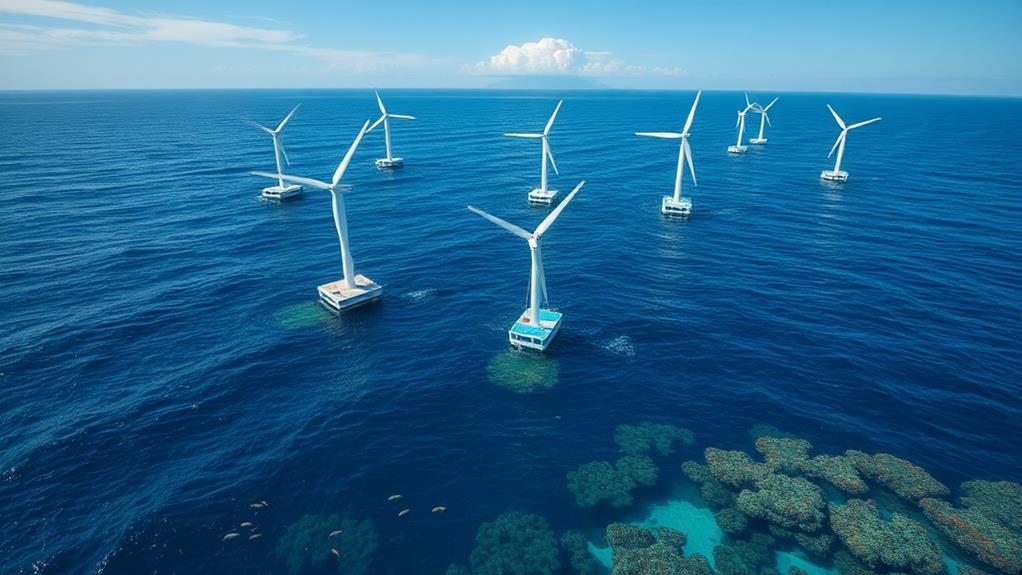
Floating wind turbines present an innovative approach to harnessing renewable energy while prioritizing environmental integrity. By deploying these turbines in deeper waters, we minimize visual and noise pollution, allowing coastal communities to enjoy the beauty of the ocean without disruption. Our innovative designs facilitate on-land manufacturing, reducing on-site disturbances to marine ecosystems. Environmental monitoring systems play a critical role in evaluating the impacts on wildlife, particularly marine mammals and fish populations, ensuring compliance with regulations. Additionally, habitat restoration efforts are integral to our projects, mitigating potential negative effects on the seabed and surrounding environments.
| Considerations | Actions Taken |
|---|---|
| Environmental Impact | Minimal through careful siting |
| Marine Ecosystems | Reduced disturbances |
| Habitat Restoration | Integrated into projects |
| Ecological Disruption | Avoided with advanced evaluations |
| Monitoring Systems | Ongoing evaluations in place |
Future Growth Opportunities
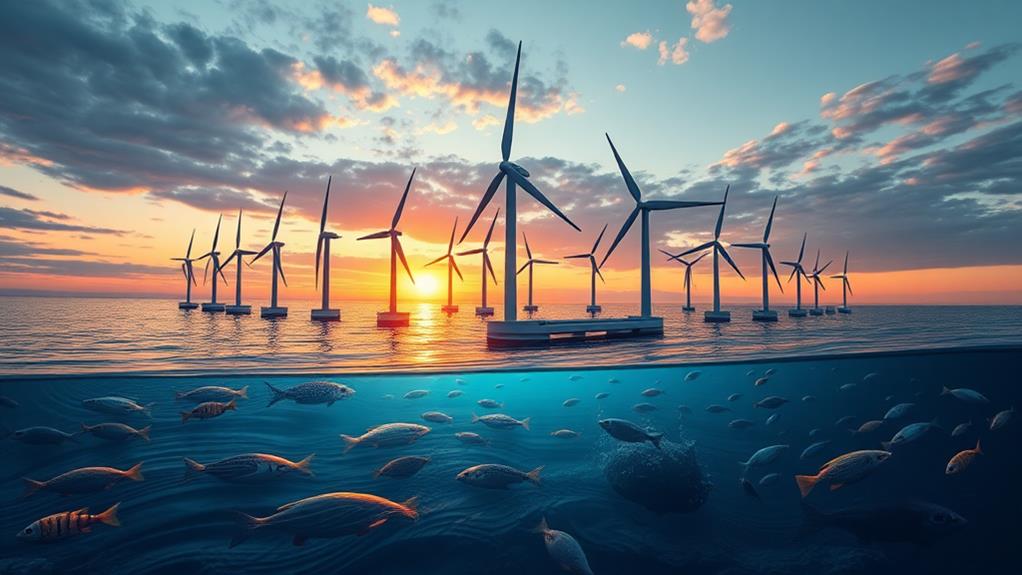
As we prioritize environmental integrity in our floating wind turbine projects, we're also excited about the immense growth opportunities on the horizon. The floating offshore wind sector is poised for significant expansion, driven by technological advancements and targeted investments. Here are some key insights:
- Projected capacity growth from 125 megawatts to over 4,000 megawatts by 2030
- Potential contribution of floating wind farms to 25% of total offshore wind capacity by 2050
- Rapid development in the European market leading to competitive landscapes
- Major countries, including the UK and the U.S., planning large-scale projects
- Innovations in platform designs enabling installations at depths of 60 to 300 meters
These factors position us for a future rich in renewable energy possibilities, fueling our commitment to sustainable solutions.
Frequently Asked Questions
What Is the New Innovation of Wind Energy?
We're excited about innovations in wind energy, like vertical axis turbines and hybrid systems. They enhance energy storage and marine engineering, aiming for cost reduction while minimizing environmental impact, giving us greater freedom in sustainable energy solutions.
What Is the New Floating Offshore Wind Shot?
Did you know the Floating Offshore Wind Shot targets 30 gigawatts by 2030? By overcoming regulatory challenges and enhancing site selection, we'll harness floating platforms, energy storage, and cost reduction while protecting marine ecology for a sustainable future.
What Are the Problems With Floating Wind Turbines?
We're facing several problems with floating wind turbines, including cost challenges, installation complexities, maintenance issues, and regulatory hurdles. These factors complicate grid integration and can lead to significant environmental impacts we must address together.
What Is the New Technology for Wind Turbine Blades?
We're excited about advancements in wind turbine blades! Innovations in blade materials enhance durability, while aerodynamic design boosts efficiency. Plus, noise reduction, maintenance technology, and recycling solutions are paving the way for a sustainable energy future.










